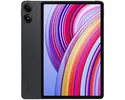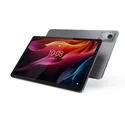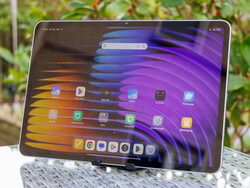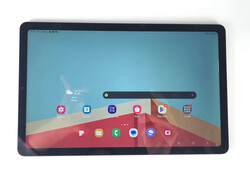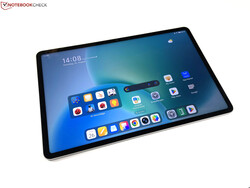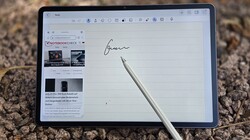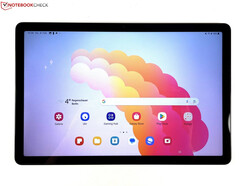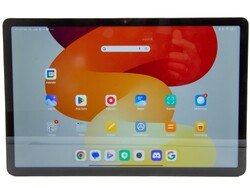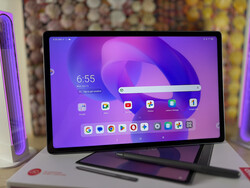
Ranking: Best tablets for under 300 dollars/euros
October 2025 update.
Here is a list of the best tablets under 300 euros tested by Notebookcheck. This ranking is regularly updated and maintained, with comments and insights to help readers make the best possible purchase decision.Marvin Gollor, ✓ Sebastian Jankowski (translated by DeepL / Ninh Duy) Published 🇩🇪 🇹🇷 ...
Years after its launch, Apple's iPad remains the benchmark in the tablet market. However, increasing competition from budget-friendly alternatives, particularly from Asian manufacturers, has pushed tablets into more affordable price ranges. While top-tier models (see our top 10 tablet rankings) still dominate the 400-euro and above segment, there are solid entry-level options under 300 euros that handle everyday tasks well. Below, we present a selection of the best budget tablets we have tested in detail.
Best tablets that are affordable (v8 rating)
Image | Model / Review | Price | Weight | Drive | Display | Screen / Body |
|---|---|---|---|---|---|---|
| Xiaomi Pad 7 Qualcomm Snapdragon 7+ Gen 3 ⎘ Qualcomm Adreno 732 ⎘ 12 GB Memory, 256 GB | Amazon: 1. $379.50 XIAOMI Pad 7 Ai WiFi Version... 2. $367.00 XIAOMI Pad 7 Ai WiFi Version... 3. $525.00 Xiaomi Pad 7 Pro Ai WiFi Ver... List Price: 400€ | 500 g | 256 GB UFS 4.0 Flash | 11.20" 3200x2136 344 PPI LCD | 86 % | |
| Alldocube iPlay 70 Mini Ultra Qualcomm Snapdragon 7+ Gen 3 ⎘ Qualcomm Adreno 732 ⎘ 12 GB Memory, 256 GB | Amazon: 1. $379.99 ALLDOCUBE iPlay 70 mini Ultr... 2. $19.99 [2025 New Version] ALLDOCUBE... 3. $8.99 Suttkue for Alldocube iPlay ... List Price: 400€ | 335 g | 256 GB UFS 3.1 Flash | 8.80" 2560x1600 343 PPI LTPS | 83 % | |
| Lenovo Idea Tab Pro MediaTek Dimensity 8300 ⎘ ARM Mali-G615 MP6 ⎘ 8 GB Memory, 256 GB | Amazon: 1. $279.99 Lenovo Idea Tab Pro with Goo... 2. $308.00 Lenovo Idea Tab Pro TB373FU ... 3. $56.99 Keyboard Case Touch for Leno... List Price: 379€ | 620 g | 256 GB UFS 4.0 Flash | 12.70" 2944x1840 273 PPI IPS | 86 % | |
| Honor Pad 10 Qualcomm Snapdragon 7 Gen 3 ⎘ Qualcomm Adreno 720 ⎘ 8 GB Memory, 256 GB | Amazon: 1. $16.19 Ibywind for Honor Pad 10 Scr... 2. $24.99 Suitable for Honor Pad 10/Ho... 3. $105.24 For Honor pick Xiaolong Zhil... List Price: 300 Euro | 525 g | 256 GB UFS 3.1 Flash | 12.10" 2560x1600 249 PPI IPS | 88 % | |
| Huawei MatePad 11.5 S HiSilicon Kirin 9000W ⎘ HiSilicon Maleoon 910 ⎘ 8 GB Memory, 256 GB | Amazon: 1. $11.96 Kepuch 2 Pack Tempered Glass... 2. $41.99 YOUULAR Tablet Case for Huaw... 3. $12.96 Kepuch Custer Case Compatibl... List Price: 399€ | 510 g | 256 GB UFS 3.1 Flash | 11.50" 2800x1840 291 PPI TFT-LCD | 85 % | |
| Lenovo Idea Tab Plus Mediatek Dimensity 6400 ⎘ ARM Mali-G57 MP2 ⎘ 8 GB Memory, 256 GB UFS 2.1 | Amazon: 1. $199.99 Lenovo Idea Tab Plus - Light... 2. $14.99 ProCase 2 Pack Screen Protec... 3. $14.99 ProCase Smart Case for 2025 ... List Price: 299 Euro | 530 g | 256 GB UFS 2.2 Flash | 12.10" 2560x1600 249 PPI IPS | 87.5 % | |
| Xiaomi Redmi Pad Pro Qualcomm Snapdragon 7s Gen 2 ⎘ Qualcomm Adreno 710 ⎘ 6 GB Memory, 128 GB UFS 2.1 | Amazon: $336.40 List Price: 380€ | 571 g | 128 GB UFS 2.2 Flash | 12.10" 2560x1600 249 PPI IPS | 83 % | |
| Oppo Pad SE Mediatek Helio G100 ⎘ ARM Mali-G57 MP2 ⎘ 8 GB Memory, 128 GB UFS 2.1 | Amazon: 1. $525.00 OPPO Pad SE 11 Inch 128GB RO... 2. $17.89 for OnePlus Pad Lite/Oppo Pa... 3. $16.98 Case for Oppo Pad SE Tablet,... List Price: 269€ | 530 g | 128 GB UFS 2.2 Flash | 11.00" 1920x1200 206 PPI IPS | 81 % | |
| OnePlus Pad Lite Mediatek Helio G100 ⎘ ARM Mali-G57 MP2 ⎘ 6 GB Memory, 128 GB UFS 2.1 | Amazon: 1. $11.99 Clear Case for OnePlus Pad L... 2. $17.89 for OnePlus Pad Lite/Oppo Pa... 3. $18.79 Case for OnePlus Pad Lite An... List Price: 200€ | 530 g | 128 GB UFS 2.2 Flash | 11.00" 1920x1200 206 PPI IPS | 82 % | |
| Lenovo Tab K11 Plus Qualcomm Snapdragon 680 4G ⎘ Qualcomm Adreno 610 ⎘ 8 GB Memory, 256 GB UFS 2.1 | Amazon: 1. $129.99 Lenovo Tab K11 TB330XU Table... 2. $267.52 Lenovo Tab K11 Plus TB352FU ... 3. $15.99 Varohix Case for Lenovo Tab ... | 520 g | 256 GB UFS 2.2 Flash | 11.45" 2000x1200 204 PPI IPS | 86.5 % |
Note: We transitioned to a new rating system in June 2024. In the updated v8 rating, certain criteria were adjusted to reflect current hardware developments, new factors were introduced, and some measurement techniques were modified. As a result, v8 ratings are slightly lower than v7 ratings and are not directly comparable to previous versions. For this reason, we currently provide two tables: one listing the best devices according to the v7 rating system and another for the v8 system. More details on the v8 rating system can be found here.
Best tablets that are affordable (v7 rating)
Image | Model / Review | Price | Weight | Drive | Display | Screen / Body |
|---|---|---|---|---|---|---|
| Samsung Galaxy Tab S6 Lite 2024 Samsung Exynos 1280 ⎘ ARM Mali-G68 MP4 ⎘ 4 GB Memory, 64 GB UFS 2.0 | Amazon: $275.21 List Price: 429€ | 467 g | 64 GB UFS 2.0 Flash | 10.40" 2000x1200 224 PPI TFT | 81.6 % | |
| Samsung Galaxy Tab A9+ Qualcomm Snapdragon 695 5G ⎘ Qualcomm Adreno 619 ⎘ 4 GB Memory, 64 GB UFS 2.1 | List Price: 249€ | 480 g | 64 GB UFS 2.2 Flash | 11.00" 1920x1200 206 PPI TFT-LCD | 81 % | |
| Samsung Galaxy Tab A9 Mediatek Helio G99 ⎘ ARM Mali-G57 MP2 ⎘ 4 GB Memory, 64 GB UFS 2.1 | Amazon: $112.99 List Price: 179€ | 332 g | 64 GB UFS 2.2 Flash | 8.70" 1340x800 179 PPI LCD TFT | 81.7 % | |
| Xiaomi Redmi Pad SE Qualcomm Snapdragon 680 4G ⎘ Qualcomm Adreno 610 ⎘ 4 GB Memory, 128 GB eMMC | Amazon: $229.99 List Price: 199.9€ | 481 g | 128 GB eMMC Flash | 11.00" 1920x1200 206 PPI TFT-LCD | 82 % |
The table above provides an overview of the best tablets under 300 euros tested by Notebookcheck in the last 12 months, along with relevant models that are still available. If multiple products have the same rating, the more recent review is ranked higher. Prices are updated daily and may vary.
Link: all tested devices in this class
Editorial comment
While our tablet rankings are usually dominated by high-end devices from Apple and Samsung, the budget segment features a diverse mix of entry-level options. Here, you’ll find both lesser-known brands from the Far East and affordable models from established manufacturers. Most tablets in this price range fall into two main size categories: 8 to 9 inches and 11 to 12 inches.
1st place – Xiaomi Pad 7
Its high display brightness of over 800 cd/m² as well as the 144 Hz refresh rate really help the Pad 7 stand out. Despite the great display, its real-world battery life leaves little to desire at around 18 to 20 hours. The SoC (Qualcomm's Snapdragon 7+ Gen3) is super fast for the price range.
Its build quality and speakers are very decent and for those who need it, stylus input is supported. A Xiaomi keyboard case is available for this tablet, too. Please note that 4G LTE or GPS are not on board, there is no fingerprint sensor and the base warranty is quite short [in Germany]. We don't expect this product to get many years of software updates, either.
The Xiaomi Pad 7 is an overall good offering thanks to its fast SoC, very good display with stylus support and long battery life.
In Germany, the tablet can currently be had for 279 euros from Kaufland, among other options.
2nd place - Alldocube iPlay 70 mini Ultra
The Alldocube iPlay 70 mini Ultra is finally an affordable 8.8-inch tablet with decent performance and a 144 Hz QHD+ display with high contrast and a brightness of over 500 cd/m², but the calibration leaves something to be desired. The performance of the built-in Snapdragon 7+ Gen 3 is also more than double that of the Helios G99 of many cheaper tablets. You also get a microSD card reader and 5 years of security updates. The battery life of 16 hours is also impressive
Less ideal are the heat development under continuous load, the mediocre speakers and camera and the lack of biometric security options.
With the iPlay 70 mini Pro, Alldocube finally offers an affordable 8-inch tablet with decent features.
Despite an RRP of 400 euros, you can get the iPlay 70 mini Ultra from Alldocube for less than 300 euros on Amazon. With the voucher code "JMPLNUZZ" it is currently only 269 euros.
3rd place - Samsung Galaxy Tab S6 Lite (2024)
The most affordable Samsung tablet with S Pen support is the Galaxy Tab S6 Lite (2024). Unlike the cheaper Tab A9+ (ranked 4th), its refresh rate is limited to 60 Hz, and it comes with just 4 GB of RAM and 64 GB of eMMC storage.
The mid-range Samsung Exynos 1280 SoC is somewhat outdated and falls well behind the Snapdragon 870 5G in the Xiaomi Pad 6 (ranked 1st). However, battery life is impressive at 12.5 to nearly 16 hours, and the tablet features solid speakers and a sturdy metal case.
For those seeking an affordable tablet with S Pen support, the Galaxy Tab S6 Lite is a solid option.
However, other budget tablets outperform it in most other areas. The 128 GB variant is currently available on Amazon DE for 222 euros.
4th place - Honor Pad 10
The Honor Pad 10 and a 12.1-inch QHD IPS display with 120 Hz, a brightness of up to 500 cd/m² and supports pen input. A Bluetooth Smart Keyboard is also available for 60 euros. The Snapdragon 7 G3 offers decent mid-range performance, while the battery life is quite long at over 14.5 hours.
The Honor Pad 10 has a robust metal casing, but lacks IP certification as well as a cellular option, GPS and a fingerprint sensor.
The Honor Pad 10 is currently available on Amazon for 269 euros. If you want to save almost 100 euros, go for the very similar predecessor model, the Honor Pad 9.
5th place - Lenovo Idea Tab Pro
In 3rd place was the Lenovo Idea Tab Pro as it is now available for less than 300 euros for the first time - not to be confused with the IdeaPad Pro Laptop series.
The 12.7-inch tablet offers a great deal: high-quality casing, stylus, fast Dimensity 8300, powerful sound, fast WLAN, expandable, fast memory and long runtimes. The 3K IPS display also offers 144 Hz, but is not very bright at just under 400 cd/m². The cameras are usable at best and the SoC throttles under load.
The Idea Tab Pro from Lenovo offers many advantages, but the low display brightness in particular limits mobile use.
The price of the Lenovo Idea Tab Pro has risen to 319 euros on Amazon.de.
6th place - Huawei MatePad 11.5 S
The Huawei MatePad 11.5 S features an 11.5-inch 2.8K 144Hz matte display with a 3:2 aspect ratio, pen support, and a fast Kirin 9000WL SoC.
Its premium metal case is just 6 mm thin and weighs only 510 grams, complemented by quality speakers and nearly 14-hour battery life. However, it lacks LTE, GPS, and its 450 cd/m² brightness is lower than some competitors.
The MatePad 11.5 S impresses with its work-friendly matte display but could improve in contrast and brightness. Saturn is currently offering it for 269 euros, with the next best price at 299 euros on Amazon DE.
7th place - Samsung Galaxy Tab A9+
The Samsung Galaxy Tab A9+ offers a 90Hz refresh rate on its 11-inch FHD IPS display, optional 5G, Samsung DeX, and four years of updates, with the Snapdragon 695 replacing its predecessor’s Unisoc T618.
It includes 64 GB of storage, 4 GB of RAM, expandable up to 1 TB via microSD (without setting it as internal storage), and a sturdy aluminum case. The four speakers deliver solid audio, and battery life reaches nearly 15.5 hours.
While the Tab A9+ provides a bright 90Hz display, DeX, and good performance at a budget price, drawbacks include slow 15W charging, no power adapter, and no fingerprint sensor. The base version is available for 165 euros on Amazon DE.
8th place - Samsung Galaxy Tab A9
The 8.7-inch Samsung Galaxy Tab A9, unlike the larger Tab A9+, features a 60-Hz display with a lower resolution of 1,340 x 800 pixels and optional 4G LTE.
For those seeking a compact tablet, the Galaxy Tab A9 is an affordable option, though it lacks a fingerprint sensor and does not include a power adapter.
It is powered by the MediaTek Helios G99 SoC paired with 4 GB of RAM and 64 GB of storage. Battery life reaches up to 19 hours, and Samsung guarantees updates for four years. Galaxus currently offers the base model for 122 euros with free shipping.
9th place - Xiaomi Redmi Pad SE
The Xiaomi Redmi Pad SE succeeds the Redmi Pad, maintaining a durable aluminum housing and an impressive 17-hour battery life, while increasing the screen size from 10.6 to 11 inches, though pixel density drops from 220 to 206 ppi. A headphone jack is now included.
The Snapdragon 680 4G is up to 30% slower than the Helio G99, particularly in single-core tasks.
Xiaomi delivers an affordable mid-range tablet with excellent quad speakers, but it lacks satellite positioning and a fingerprint sensor.
The 90Hz FHD+ IPS display is now 50 cd/m² brighter at 450 cd/m² and covers around 93% of sRGB. The 8GB RAM/256GB model is priced at 177 euros, while the 4GB/128GB version is available for 145 euros on Amazon DE.
10th place - Lenovo Idea Tab Plus
The affordable 12.1-inch Lenovo Idea Tab Plus tablet comes with a QHD+ 90Hz IPS display with 600 nits, 8 GB RAM and 256 GB ROM. Inside the stylish and high-quality metal casing is the unfortunately not quite nimble mid-range SoC Mediatek Dimensity 6400. The memory can at least be expanded via microSD and a stylus is included in the scope of delivery. However, there is no fingerprint reader.
The cameras are also not very convincing. The speakers, on the other hand, deliver a decent sound and it charges with a full 45 watts. The battery life of just under 15 hours is also impressive.
The lightweight 12-inch Lenovo Idea Tab Plus tablet offers precise GPS, but no mobile phone version - protection against dust and water is only rudimentary and there is no hope of long updates.
The Lenovo Idea Pad Plus is currently available from Galaxus for 289 euros with 8 GB RAM and 256 GB memory.
The best tablets for under 300 dollars/euros: Overview
Measurements
| Xiaomi Pad 7 Adreno 732, SD 7+ Gen 3, 256 GB UFS 4.0 Flash | Alldocube iPlay 70 Mini Ultra Adreno 732, SD 7+ Gen 3, 256 GB UFS 3.1 Flash | Samsung Galaxy Tab S6 Lite 2024 Mali-G68 MP4, Exynos 1280, 64 GB UFS 2.0 Flash | Honor Pad 10 Adreno 720, SD 7 Gen 3, 256 GB UFS 3.1 Flash | Lenovo Idea Tab Pro Mali-G615 MP6, Dimensity 8300, 256 GB UFS 4.0 Flash | Huawei MatePad 11.5 S Maleoon 910, Kirin 9000W, 256 GB UFS 3.1 Flash | Samsung Galaxy Tab A9+ Adreno 619, SD 695 5G, 64 GB UFS 2.2 Flash | Samsung Galaxy Tab A9 Mali-G57 MP2, Helio G99, 64 GB UFS 2.2 Flash | Xiaomi Redmi Pad SE Adreno 610, SD 680, 128 GB eMMC Flash | Lenovo Idea Tab Plus Mali-G57 MP2, Dimensity 6400, 256 GB UFS 2.2 Flash | |
|---|---|---|---|---|---|---|---|---|---|---|
| Response Times | ||||||||||
| Response Time Grey 50% / Grey 80% * (ms) | 30.94 ? | 26.67 ? | 43.1 ? | 24.6 ? | 37.4 ? | 29.48 ? | 53.81 ? | 52.61 ? | 47.92 ? | 22.7 ? |
| Response Time Black / White * (ms) | 15.78 ? | 12.56 ? | 21.1 ? | 13 ? | 20.3 ? | 14.82 ? | 29.92 ? | 34.71 ? | 26.38 ? | 14.1 ? |
| PWM Frequency (Hz) | ||||||||||
| PWM Amplitude * (%) | ||||||||||
| Screen | ||||||||||
| Brightness middle (cd/m²) | 838 | 555 | 486 | 529 | 409 | 511 | 493 | 486 | 473 | 633 |
| Brightness (cd/m²) | 815 | 523 | 466 | 499 | 388 | 449 | 460 | 462 | 449 | 622 |
| Brightness Distribution (%) | 96 | 88 | 92 | 91 | 89 | 83 | 90 | 92 | 85 | 95 |
| Black Level * (cd/m²) | 0.88 | 0.46 | 0.26 | 0.5 | 0.4 | 0.99 | 0.35 | 0.35 | 0.28 | 0.54 |
| Contrast (:1) | 952 | 1207 | 1869 | 1058 | 1023 | 516 | 1409 | 1389 | 1689 | 1172 |
| Colorchecker dE 2000 * | 1.8 | 6.4 | 2.29 | 2 | 3.46 | 3.6 | 6 | 6.2 | 3 | 1.81 |
| Colorchecker dE 2000 max. * | 3.9 | 12.6 | 6.82 | 4.79 | 5.46 | 7.5 | 11.7 | 10.4 | 6 | 2.98 |
| Greyscale dE 2000 * | 2.5 | 9.1 | 2.8 | 3.6 | 5.2 | 5.5 | 8.2 | 5.7 | 2.7 | 2.5 |
| Gamma | 2.25 98% | 2.31 95% | 2.229 99% | 2.248 98% | 2.106 104% | 2.27 97% | 2.21 100% | 2.12 104% | 2.27 97% | 1.934 114% |
| CCT | 6912 94% | 9616 68% | 7145 91% | 7398 88% | 5823 112% | 7566 86% | 9131 71% | 7911 82% | 6589 99% | 6853 95% |
| Heat | ||||||||||
| Maximum Upper Side * (°C) | 41.7 | 52.2 | 39.5 | 39.9 | 34.3 | 41.2 | 41.3 | 36.1 | 35 | 31.4 |
| Maximum Bottom * (°C) | 39.4 | 46.4 | 35.9 | 40 | 33.5 | 41.3 | 39.1 | 35.5 | 34.1 | 32.2 |
| Idle Upper Side * (°C) | 31.3 | 33.5 | 23.3 | 25.6 | 27.1 | 32.3 | 29.3 | 29.1 | 32.1 | 24.6 |
| Idle Bottom * (°C) | 27.8 | 27.9 | 24.1 | 26.2 | 26.9 | 30.6 | 27.6 | 27.4 | 28.9 | 25.3 |
| Battery runtime | ||||||||||
| Reader / Idle (h) | 41.4 | 51 | 25.4 | 37.9 | 32.2 | 70.6 | ||||
| WiFi v1.3 (h) | 18.1 | 15.9 | 12.6 | 14.7 | 13.3 | 13.9 | 15.3 | 14.3 | 17 | 14.9 |
| Load (h) | 4 | 4.8 | 4.3 | 4.1 | 4.6 | 3.9 | ||||
| Power Consumption | ||||||||||
| Idle Minimum * (Watt) | 0.74 | 1.36 | 1.2 | 4.4 | 1.2 | 1.53 | 1 | 0.7 | 0.63 | 1.9 |
| Idle Average * (Watt) | 1.72 | 4.16 | 1.4 | 4.7 | 1.8 | 5.96 | 4.76 | 2.94 | 4.25 | 2.1 |
| Idle Maximum * (Watt) | 1.74 | 4.21 | 1.8 | 5.2 | 2.8 | 6.07 | 4.79 | 3.03 | 4.34 | 2.4 |
| Load Average * (Watt) | 7.26 | 2.5 | 8.5 | 7.9 | 6.87 | 9.52 | 7.49 | 10.24 | 5.9 | |
| Load Maximum * (Watt) | 8.11 | 8.3 | 11.3 | 10.8 | 6.88 | 9.92 | 8.02 | 10.47 | 7.3 |
* ... smaller is better
Benchmark scores
| 3DMark | |
| 2560x1440 Sling Shot OpenGL ES 3.0 (sort by value) | |
| Samsung Galaxy Tab A9+ | |
| Samsung Galaxy Tab A9 | |
| Xiaomi Redmi Pad SE | |
| 2560x1440 Sling Shot OpenGL ES 3.0 Graphics (sort by value) | |
| Samsung Galaxy Tab A9+ | |
| Xiaomi Redmi Pad SE | |
| 2560x1440 Sling Shot OpenGL ES 3.0 Physics (sort by value) | |
| Samsung Galaxy Tab A9+ | |
| Xiaomi Redmi Pad SE | |
| WebXPRT 3 - Overall (sort by value) | |
| Xiaomi Pad 7 | |
| Samsung Galaxy Tab S6 Lite 2024 | |
| Samsung Galaxy Tab A9+ | |
| Samsung Galaxy Tab A9 | |
| Xiaomi Redmi Pad SE | |
| PUBG Mobile - HD (sort by value) | |
| Xiaomi Pad 7 | |
| Samsung Galaxy Tab S6 Lite 2024 | |
| Honor Pad 10 | |
| Lenovo Idea Tab Pro | |
| Huawei MatePad 11.5 S | |
| Samsung Galaxy Tab A9+ | |
| Samsung Galaxy Tab A9 | |










